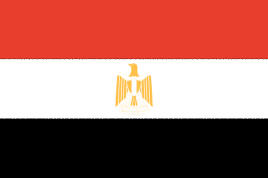
|

|
Egypt/Italy Tour 2003: About the tour: Egypt
General
This page has some general information about the Egypt part of the tour.
Disclaimer
First a disclaimer. I am not an expert on Egypt - neither on the modern state nor on Egypt's great historical past. This was my first visit to the country and indeed the first visit to the Middle East. Any errors or misconceptions are entirely my responsibility and I apologise in advance for them.
Furthermore, in the month or so before going to Egypt both Linda are I were extremely busy as stage manager and musical director respectively of Reps production of Annie. Add to that the work needed to get away from the office and the preparations for the holiday and it is perhaps understandable why pre-tour research was not done. I should add that Linda had been to Egypt before in 1980 and so she had a good knowledge of the basic information.
Basic Geography
Egypt lies between latitudes 22º and 32º north. The extreme south of the country therefore lies within the tropics but most of the country is just outside, to the north. Cairo in particular is at 30º north.
From a vegetation point of view and simplifying somewhat, the country may be divided into three parts: the Western desert, the Nile valley and the Eastern Desert.
Nile valley
In our visit we saw only the Nile valley. This is an intensely cultivated, fertile valley bordering the northward-flowing Nile river. Within this quite narrow (8-16 kms wide) fertile strip (and the Nile Delta) live 99% of the population of Egypt.
On either side of the river valley, one can see the desert lands. Sometimes there are quite steep escarpment hills bordering the river and naturally the desert like surroundings make a sharp contrast with the dense riverine vegetation.
Pictures of this valley and the surrounding desert may be seen in the pictures taken from the top of a Nile cruiser on 18th April.
Western and Eastern Deserts
The Western Desert is the larger of the two main desert areas. It is mainly devoid of life. The Eastern Desert is a limestone and sandstone plateau extensively dissected by wadis and its intermittent rainfall supports some scrubby vegetation. As I mentioned, we didn't see either of these areas but we plan to on our next trip.
Rainfall
This is extremely low generally, ranging from 7 inches at Alexandria to about 1 inch at Cairo and only about 0.1 inches at Aswan.
Plants
Botanically speaking, I don't think we saw any native vegetation at all. As the encyclopaedia says, the Nile valley is intensively cultivated (and presumably has been for many centuries) so there is nothing native left there (or at least we didn't see it) and the surrounding desert areas seemed to be devoid of any vegetation.
Street trees
The planted trees of Cairo, of which there were many and which looked very interesting, had a slightly familiar component which overlapped with home. For example, we saw jacarandas in flower. This was in April, which is presumably the northern hemisphere equivalent timing to our spring flowering in September/October.
From the internet, I notice that there is a checklist of Egyptian plants [1] and a book on street trees [2], one of whose authors is Loutfy Boulos, whom I once met very briefly years ago when he visited Harare. I doubt if there is time to get a copy of it before we go again - it really is a shame that such information cannot be disseminated via the Internet.
The Nile
There are no crocodiles left in the Nile; the last ones were exterminated many years ago. From a Zimbabwean perspective their absence seems somewhat strange in such a major perennial river. I was also surprised that there appeared to be no invasive water weeds such as the water hyacinth (Eichhornia crassipes), the water lettuce (Pistia stratiotes) or Salvinia.
Sources of information
Our two guides Ashraf and Bakr were our primary sources of information. Additional information was supplied by Corrado Trinci, who provided the captions for the pictures on the Egyptian leg of the trip and some of the Italian ones was well. I made copious notes at the time in an old black 1999 diary.
Writing this up now (late November, 2003), the dairy was obviously very useful as also was Swans 600 Mile Nile Cruise (9th edition, 1977). compiled by various authors and published by WF and RK Swan (Hellenic) Ltd.
[1] Boulos, L. (1995). Flora of Egypt Checklist. Al Hadara Publishing, Cairo.
[2] El Hadidi, M.N. and Boulos, L. (1979). Street Trees of Egypt, Ed. 2., Fac. Sci., Cairo University Herbarium.